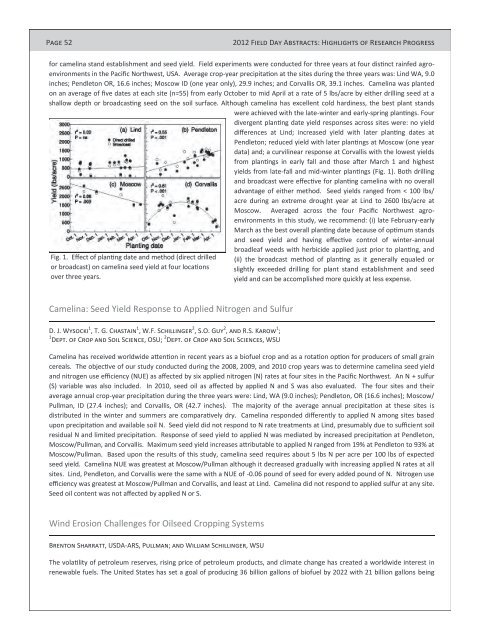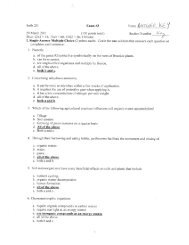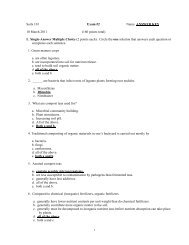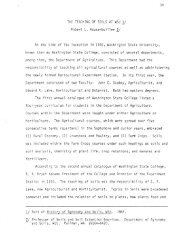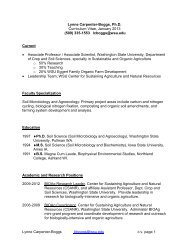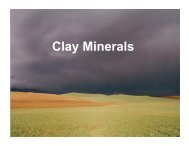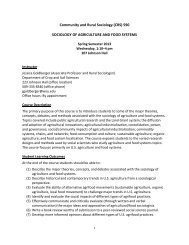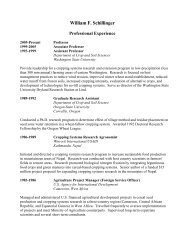2012 Dryland Field Day Abstracts - Dept. of Crop and Soil Sciences ...
2012 Dryland Field Day Abstracts - Dept. of Crop and Soil Sciences ...
2012 Dryland Field Day Abstracts - Dept. of Crop and Soil Sciences ...
Create successful ePaper yourself
Turn your PDF publications into a flip-book with our unique Google optimized e-Paper software.
Page 52<br />
<strong>2012</strong> <strong>Field</strong> <strong>Day</strong> <strong>Abstracts</strong>: Highlights <strong>of</strong> Research Progress<br />
for camelina st<strong>and</strong> establishment <strong>and</strong> seed yield. <strong>Field</strong> experiments were conducted for three years at four distinct rainfed agroenvironments<br />
in the Pacific Northwest, USA. Average crop-year precipitation at the sites during the three years was: Lind WA, 9.0<br />
inches; Pendleton OR, 16.6 inches; Moscow ID (one year only), 29.9 inches; <strong>and</strong> Corvallis OR, 39.1 inches. Camelina was planted<br />
on an average <strong>of</strong> five dates at each site (n=55) from early October to mid April at a rate <strong>of</strong> 5 lbs/acre by either drilling seed at a<br />
shallow depth or broadcasting seed on the soil surface. Although camelina has excellent cold hardiness, the best plant st<strong>and</strong>s<br />
were achieved with the late-winter <strong>and</strong> early-spring plantings. Four<br />
divergent planting date yield responses across sites were: no yield<br />
differences at Lind; increased yield with later planting dates at<br />
Pendleton; reduced yield with later plantings at Moscow (one year<br />
data) <strong>and</strong>; a curvilinear response at Corvallis with the lowest yields<br />
from plantings in early fall <strong>and</strong> those after March 1 <strong>and</strong> highest<br />
yields from late-fall <strong>and</strong> mid-winter plantings (Fig. 1). Both drilling<br />
<strong>and</strong> broadcast were effective for planting camelina with no overall<br />
advantage <strong>of</strong> either method. Seed yields ranged from < 100 lbs/<br />
acre during an extreme drought year at Lind to 2600 lbs/acre at<br />
Moscow. Averaged across the four Pacific Northwest agroenvironments<br />
in this study, we recommend: (i) late February-early<br />
March as the best overall planting date because <strong>of</strong> optimum st<strong>and</strong>s<br />
<strong>and</strong> seed yield <strong>and</strong> having effective control <strong>of</strong> winter-annual<br />
Fig. 1. Effect <strong>of</strong> planting date <strong>and</strong> method (direct drilled<br />
or broadcast) on camelina seed yield at four locations<br />
over three years.<br />
Camelina: Seed Yield Response to Applied Nitrogen <strong>and</strong> Sulfur<br />
D. J. Wysocki 1 , T. G. Chastain 1 , W.F. Schillinger 2 , S.O. Guy 2 , <strong>and</strong> R.S. Karow 1 ;<br />
1 <strong>Dept</strong>. <strong>of</strong> <strong>Crop</strong> <strong>and</strong> <strong>Soil</strong> Science, OSU; 2 <strong>Dept</strong>. <strong>of</strong> <strong>Crop</strong> <strong>and</strong> <strong>Soil</strong> <strong>Sciences</strong>, WSU<br />
broadleaf weeds with herbicide applied just prior to planting, <strong>and</strong><br />
(ii) the broadcast method <strong>of</strong> planting as it generally equaled or<br />
slightly exceeded drilling for plant st<strong>and</strong> establishment <strong>and</strong> seed<br />
yield <strong>and</strong> can be accomplished more quickly at less expense.<br />
Camelina has received worldwide attention in recent years as a bi<strong>of</strong>uel crop <strong>and</strong> as a rotation option for producers <strong>of</strong> small grain<br />
cereals. The objective <strong>of</strong> our study conducted during the 2008, 2009, <strong>and</strong> 2010 crop years was to determine camelina seed yield<br />
<strong>and</strong> nitrogen use efficiency (NUE) as affected by six applied nitrogen (N) rates at four sites in the Pacific Northwest. An N + sulfur<br />
(S) variable was also included. In 2010, seed oil as affected by applied N <strong>and</strong> S was also evaluated. The four sites <strong>and</strong> their<br />
average annual crop-year precipitation during the three years were: Lind, WA (9.0 inches); Pendleton, OR (16.6 inches); Moscow/<br />
Pullman, ID (27.4 inches); <strong>and</strong> Corvallis, OR (42.7 inches). The majority <strong>of</strong> the average annual precipitation at these sites is<br />
distributed in the winter <strong>and</strong> summers are comparatively dry. Camelina responded differently to applied N among sites based<br />
upon precipitation <strong>and</strong> available soil N. Seed yield did not respond to N rate treatments at Lind, presumably due to sufficient soil<br />
residual N <strong>and</strong> limited precipitation. Response <strong>of</strong> seed yield to applied N was mediated by increased precipitation at Pendleton,<br />
Moscow/Pullman, <strong>and</strong> Corvallis. Maximum seed yield increases attributable to applied N ranged from 19% at Pendleton to 93% at<br />
Moscow/Pullman. Based upon the results <strong>of</strong> this study, camelina seed requires about 5 lbs N per acre per 100 lbs <strong>of</strong> expected<br />
seed yield. Camelina NUE was greatest at Moscow/Pullman although it decreased gradually with increasing applied N rates at all<br />
sites. Lind, Pendleton, <strong>and</strong> Corvallis were the same with a NUE <strong>of</strong> -0.06 pound <strong>of</strong> seed for every added pound <strong>of</strong> N. Nitrogen use<br />
efficiency was greatest at Moscow/Pullman <strong>and</strong> Corvallis, <strong>and</strong> least at Lind. Camelina did not respond to applied sulfur at any site.<br />
Seed oil content was not affected by applied N or S.<br />
Wind Erosion Challenges for Oilseed <strong>Crop</strong>ping Systems<br />
Brenton Sharratt, USDA-ARS, Pullman; <strong>and</strong> William Schillinger, WSU<br />
The volatility <strong>of</strong> petroleum reserves, rising price <strong>of</strong> petroleum products, <strong>and</strong> climate change has created a worldwide interest in<br />
renewable fuels. The United States has set a goal <strong>of</strong> producing 36 billion gallons <strong>of</strong> bi<strong>of</strong>uel by 2022 with 21 billion gallons being


